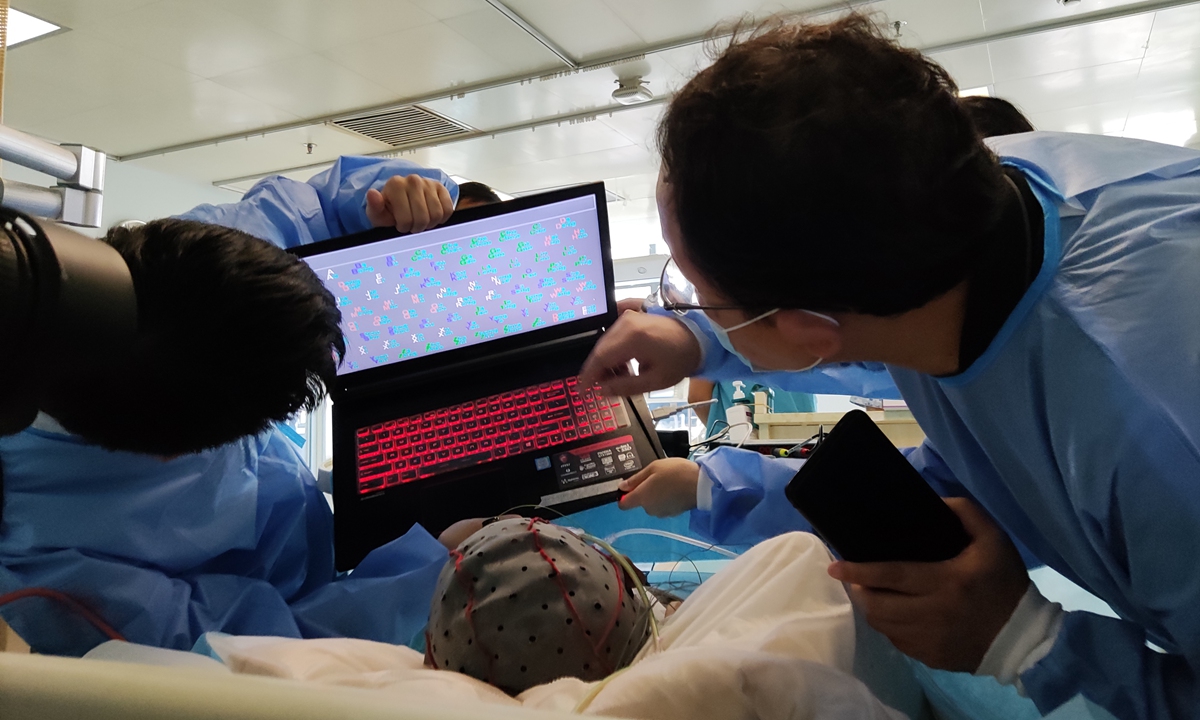Brain-computer interface technology helps paralyzed patient say 'Hello'
By Li Qiao Source: Global Times Published: 2020/8/21 1:30:05

Photo: Courtesy of Wang Gang
Once only conceivable as a scene from science fiction, a patient with high paraplegic and aphasia said "Hello," at the Second Affiliated Hospital of Xi'an Jiaotong University, Northwest China's Shaanxi Province.
It is brain-computer interface (BCI) technology that made it happen, supported by the Second Affiliated Hospital of Xi'an Jiaotong University, in conjunction with the School of Mechanical Engineering under Xi 'an Jiaotong University, which was reported as the first case all over the world and has attracted much attention.
The patient, whose spinal cord was damaged after a fall from a high position, can only communicate with doctors through blinking of the eyes. But through BCI technology, the patient can "speak" his thoughts by looking at a computer screen pulsating with characters or pinyin.
"This is the first case in ICU medical field around the world, according to our research. To say 'Hello' is just the first successful step. We are planning to expand the language menu and help ICU patients to express more as they want through BCI technology," Wang Gang, the deputy director of ICU department at the hospital, told the Global Times on Wednesday.
From 'Hello' to better communication
BCI is a technology that uses various electrodes to collect bioelectrical signals generated by brain activity, and then processes and analyzes the signals through a computer to decode signals such as movement and vision, so as to achieve human-computer interaction, according to Xinhua News Agency.
At present, BCI technology has been widely used in education, military, medical and other fields.
In the medical field, BCI can be used to diagnose brain neurological diseases, predict and suppress the onset of epilepsy, and assist the rehabilitation training of stroke patients, etc.
However, the application of BCI in the field of critical care medicine is still limited. The simple "Hello" represents a big step forward in the use of BCI in critically ill patients, Wang said.
It is expected to enable more effective communication between patients losing speech function, medical staff and their families, as well as help patients express their inner thoughts more accurately in Wang's study.
There are two models for patients currently, Wang introduced. One is to provide present problems and answers where patients can select their choices by looking at the appropriate image.
For example, there are flashing black and white images under two words: eating and drinking. It looks like they are flashing without difference, but there is still a difference in their flashing frequency which can trigger different electroencephalogram in the brain.
BCI technology can collect electroencephalogram and analyze the difference in frequency to tell which image the patient is staring at, and then translate if they want to eat or drink.
Another model is similar to typing. The patient can spell out what they want to say by looking at 26 letters on the screen. The "hello" was spelt out in this way, Wang introduced.
"ICU medical staff usually asks patients to blink their eyes and ask them 'are you thirsty' or 'would you like to go to the bathroom?' If the patient has something else they want to express, such as which relatives they want to see, doctors can't know exactly," Wang said.
He noted BCI technology can help patients express their different thoughts and more advanced needs.
Wang expressed shock when this patient successfully said "Hello" at the first try within 20 seconds as the research team worried the brain waves would be abnormal as falling from tall heights may damage the brain to some extent.
"Patients with large cerebral infarction or ischemia have abnormal brain waves, making attempts to use BCI technology less successful," Wang said adding that "with the development of BCI tech, I wish more patients suffering from serious encephalopathy can also speak out."
The doctors, with the professor providing tech support, are considering replacing the display with a tablet or phone to make the device more portable and able to be installed next to the patient's bed.
In the future, Wang hopes the BCI technology will capture not only signals from the visual centers, but also the frontal, parietal and hippocampus regions of the brain, which are involved in complex brain signals related to thoughts, emotions and memories.
Humanistic care
The hospital has researched how BCI technology applies for critical care treatment, with the support of Professor Xu Guanghua from the School of Mechanical Engineering under Xi 'an Jiaotong University for one year.
The BCI research at Xi'an Jiaotong University is top in China and there was no report about the technology helps ICU patients with high paraplegic and aphasia speak successfully before their attempts, according to Wang.
The experience of aiding Wuhan fighting against COVID-19 inspired Wang to promote this BCI clinical study as soon as possible after his return at the end of April.
"As ICU doctors, we usually make more efforts on clinical treatment. However, there is no specific treatment toward the novel coronavirus. I thought more about how to make severe patients feel more relaxed, reduce their anxiety and depression, and how to further conduct humanistic care," Wang explained.
He expressed hope the patients can tell where they are uncomfortable after the intubation so doctors can help in a targeted way.
Many patients only can blink before they die, apparently with last words they want to leave with their families. It is also hoped that in the future the technology will help these patients leave their last words to the world, Wang said.